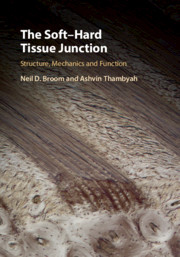
-
Select format
-
- Publisher:
- Cambridge University Press
- Publication date:
- 13 November 2018
- 29 November 2018
- ISBN:
- 9781316481042
- 9781107137868
- Dimensions:
- (247 x 174 mm)
- Weight & Pages:
- 0.95kg, 400 Pages
- Dimensions:
- Weight & Pages:
- Subjects:
- Life Sciences, Engineering, Bioengineering, Biomedical Engineering
You may already have access via personal or institutional login- Subjects:
- Life Sciences, Engineering, Bioengineering, Biomedical Engineering
Book description
Richly illustrated throughout with actual tissue images, this innovative book shows that the soft-hard tissue junction is best understood in a biomechanical context. The authors describe their pioneering experimental methods, providing an essential structure-function framework for computational modelling, and thereby encouraging the development of more realistic, predictive models of this important tissue junction. Covering the three main musculoskeletal junctions of cartilage-bone, disc-vertebra, and ligament/tendon-bone, the relevant soft tissues are examined with respect to both their own inherent structure and their mode of integration with the hard tissue. The soft-hard tissue interface is explored with a focus on structural damage resulting from overloading, and its associated pathologies. Adopting a multiscale approach, ranging in structural resolution from the macro to fibril levels, this is a must-have guide to the field and an ideal resource for researchers seeking new and creative approaches for studying the joint and spine tissues.
Contents
Metrics
Altmetric attention score
Full text views
Full text views help Loading metrics...
Loading metrics...
* Views captured on Cambridge Core between #date#. This data will be updated every 24 hours.
Usage data cannot currently be displayed.
Accessibility standard: Unknown
Why this information is here
This section outlines the accessibility features of this content - including support for screen readers, full keyboard navigation and high-contrast display options. This may not be relevant for you.
Accessibility Information
Accessibility compliance for the PDF of this book is currently unknown and may be updated in the future.


